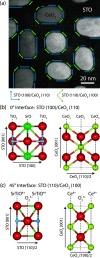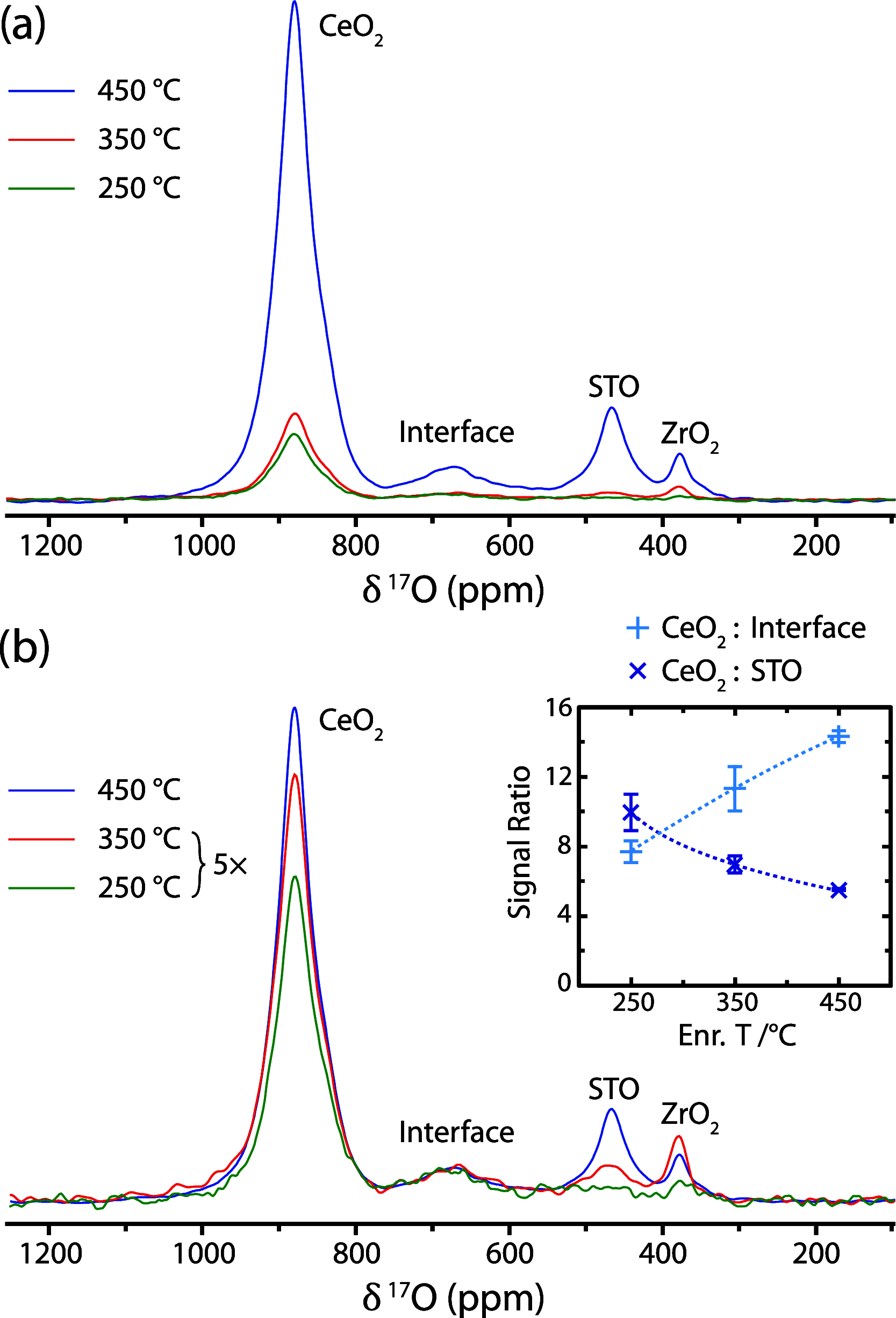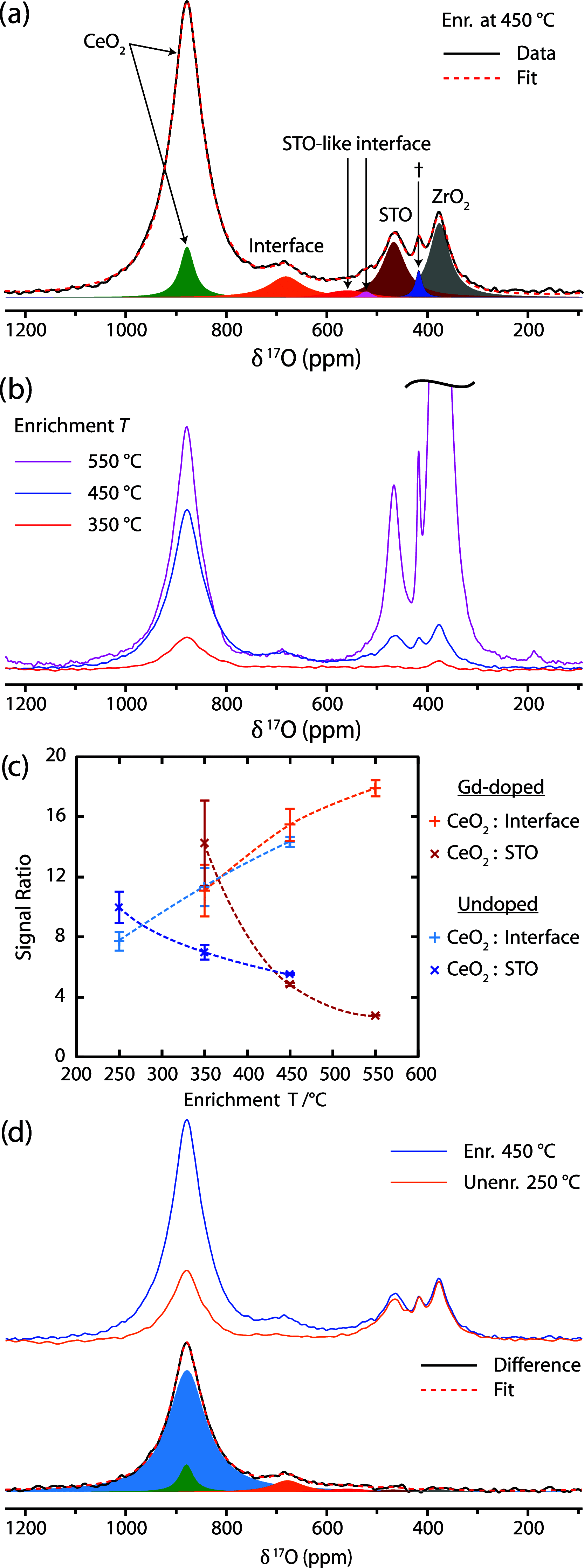Revealing the Structure and Oxygen Transport at Interfaces in Complex Oxide Heterostructures via 17O NMR Spectroscopy
- PMID: 32982045
- PMCID: PMC7513580
- DOI: 10.1021/acs.chemmater.0c02698
Revealing the Structure and Oxygen Transport at Interfaces in Complex Oxide Heterostructures via 17O NMR Spectroscopy
Abstract
Vertically aligned nanocomposite (VAN) films, comprising nanopillars of one phase embedded in a matrix of another, have shown great promise for a range of applications due to their high interfacial areas oriented perpendicular to the substrate. In particular, oxide VANs show enhanced oxide-ion conductivity in directions that are orthogonal to those found in more conventional thin-film heterostructures; however, the structure of the interfaces and its influence on conductivity remain unclear. In this work, 17O NMR spectroscopy is used to study CeO2-SrTiO3 VAN thin films: selective isotopic enrichment is combined with a lift-off technique to remove the substrate, facilitating detection of the 17O NMR signal from single atomic layer interfaces. By performing the isotopic enrichment at variable temperatures, the superior oxide-ion conductivity of the VAN films compared to the bulk materials is shown to arise from enhanced oxygen mobility at this interface; oxygen motion at the interface is further identified from 17O relaxometry experiments. The structure of this interface is solved by calculating the NMR parameters using density functional theory combined with random structure searching, allowing the chemistry underpinning the enhanced oxide-ion transport to be proposed. Finally, a comparison is made with 1% Gd-doped CeO2-SrTiO3 VAN films, for which greater NMR signal can be obtained due to paramagnetic relaxation enhancement, while the relative oxide-ion conductivities of the phases remain similar. These results highlight the information that can be obtained on interfacial structure and dynamics with solid-state NMR spectroscopy, in this and other nanostructured systems, our methodology being generally applicable to overcome sensitivity limitations in thin-film studies.
Copyright © 2020 American Chemical Society.
Conflict of interest statement
The authors declare no competing financial interest.
Figures






Similar articles
-
Solid State NMR Spectroscopy a Valuable Technique for Structural Insights of Advanced Thin Film Materials: A Review.Nanomaterials (Basel). 2021 Jun 4;11(6):1494. doi: 10.3390/nano11061494. Nanomaterials (Basel). 2021. PMID: 34200088 Free PMC article. Review.
-
Low Area Specific Resistance La-Doped Bi2O3 Nanocomposite Thin Film Cathodes for Solid Oxide Fuel Cell Applications.Nano Lett. 2024 Dec 11;24(49):15575-15581. doi: 10.1021/acs.nanolett.4c03679. Epub 2024 Nov 26. Nano Lett. 2024. PMID: 39588787 Free PMC article.
-
Strongly enhanced oxygen ion transport through samarium-doped CeO2 nanopillars in nanocomposite films.Nat Commun. 2015 Oct 8;6:8588. doi: 10.1038/ncomms9588. Nat Commun. 2015. PMID: 26446866 Free PMC article.
-
Self-assembled vertically aligned Ni nanopillars in CeO2 with anisotropic magnetic and transport properties for energy applications.Nanoscale. 2018 Sep 20;10(36):17182-17188. doi: 10.1039/c8nr05532g. Nanoscale. 2018. PMID: 30191234
-
Ionic conductivity in oxide heterostructures: the role of interfaces.Sci Technol Adv Mater. 2010 Nov 17;11(5):054503. doi: 10.1088/1468-6996/11/5/054503. eCollection 2010 Oct. Sci Technol Adv Mater. 2010. PMID: 27877360 Free PMC article. Review.
Cited by
-
Looking into the dynamics of molecular crystals of ibuprofen and terephthalic acid using 17 O and 2 H nuclear magnetic resonance analyses.Magn Reson Chem. 2021 Sep;59(9-10):975-990. doi: 10.1002/mrc.5141. Epub 2021 May 6. Magn Reson Chem. 2021. PMID: 33615550 Free PMC article.
-
Solid State NMR Spectroscopy a Valuable Technique for Structural Insights of Advanced Thin Film Materials: A Review.Nanomaterials (Basel). 2021 Jun 4;11(6):1494. doi: 10.3390/nano11061494. Nanomaterials (Basel). 2021. PMID: 34200088 Free PMC article. Review.
-
Composition and Structure of the solid electrolyte interphase on Na-Ion Anodes Revealed by Exo- and Endogenous Dynamic Nuclear Polarization─NMR Spectroscopy.J Am Chem Soc. 2024 Sep 4;146(35):24476-24492. doi: 10.1021/jacs.4c06823. Epub 2024 Aug 22. J Am Chem Soc. 2024. PMID: 39169891 Free PMC article.
References
-
- MacManus-Driscoll J. L. Self-Assembled Heteroepitaxial Oxide Nanocomposite Thin Film Structures: Designing Interface-Induced Functionality in Electronic Materials. Adv. Funct. Mater. 2010, 20, 2035–2045. 10.1002/adfm.201000373. - DOI
-
- Choi E.-M.; Di Bernardo A.; Zhu B.; Lu P.; Alpern H.; Zhang K. H. L.; Shapira T.; Feighan J.; Sun X.; Robinson J.; et al. 3D Strain-Induced Superconductivity in La2CuO4+δ Using a Simple Vertically Aligned Nanocomposite Approach. Sci. Adv. 2019, 5, eaav553210.1126/sciadv.aav5532. - DOI - PMC - PubMed
